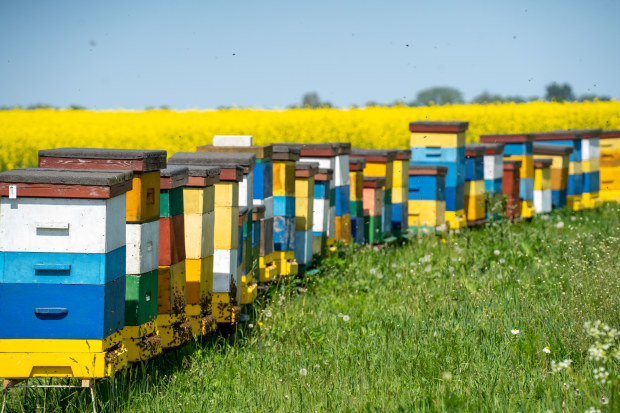Sponsored by Nuveen
Impact investing - an alternative approach goes mainstream
Terms such as ESG (environmental, social and governance), sustainability and impact investing are often used interchangeably. In fact, these terms describe very different approaches to integrating social and environmental factors into investment decision-making.
As global regulations solidify, and governments and the private sector alike aim to meet the targets outlined in the Paris agreement, these differences are important to understand and acknowledge.

Impact investing is differentiated from other strategies as it aims achieve social or environmental impact. Nuveen has installed 1,300+ beehives on Polish farms since 2021, boosting pollination, biodiversity, and crop quality.
ESG integration is a framework used to assess potential risks and opportunities through the consideration of financially material environmental, social and governance factors. Traditional fund managers may incorporate ESG data or considerations into their investment approach, but can buy any security if they feel the price provides sufficient upside or compensation for bearing the fundamental ESG risks.
Sustainable investing refers to a range of investment strategies– including negative screening, positive screening, impact investing, thematic investing, and corporate engagement.
Impact investing, meanwhile, is investing to achieve intentional positive social and/or environmental outcomes - requiring the measurement and documentation of impact metrics that demonstrate the intentionality of the investor and investee.
While these three terms often get lumped together, impact investing is differentiated from other strategies by its intentionality to achieve social and/or environmental impact through direct and measurable outcomes.
For Andrew Kleinig, managing director and head of Australia at global asset manager, Nuveen, impact investing is moving from its position as an outlier to centre stage in many Australian portfolios.
“Impact investing is one of the largest areas that we are being asked about,” Kleinig says, adding that it is now among the top three enquiries from clients.

Andrew Kleinig, managing director and head of Australia at Nuveen.
“Because there’s an increasing focus from institutional capital’s underlying membership base – whether that’s private wealth, family offices or superannuation funds looking to align with their membership – we are now starting to see the creation of standalone impact investing sleeves alongside their traditional balanced option.”
He says the opportunities for investors in Australia are myriad but also subtly different – and contingent on local conditions – compared with global assets.
While renewables such as wind power and solar have been a staple of impact investing globally for some years, in Australia this energy sector is just beginning take shape.
“There’s an incredible opportunity within the renewable energy space in Australia,” says Kleinig. “Solar is an area that we think is ripe for institutional investment and certainly something that’s needed by the broader Australian population.”
On the social front, current government policy will likely favour institutional investment in the housing sector.
“Clearly the current federal government is attempting to move the dial on housing policy in Australia, and we do think there is a huge opportunity for institutional capital to play a role in the provision of what we would call workforce housing,” he says, adding that institutional investors are also likely to see good returns from private sector affordable housing developments.
Land is another hot impact investing opportunity for Australian investors.
“We definitely have been looking at natural capital in terms of farmland, timberland and regenerative agriculture as an area where institutional investors are likely to see a unique balance of financial, nature, and climate benefits,” says Kleinig.
Nuveen has been working with governmental and non-governmental organisations looking at ways impact investing can benefit an agricultural sector that will, in the future, need to produce more food and fibre with less land while meeting climate and nature-positive goals thereby creating new ecosystem services revenue streams.
“There needs to be more discussion around catalysing domestic capital to invest in agriculture, which I think it’s fair to say, has been relatively minimal particularly when you compare what offshore investors have been allocating into Australia,” Kleinig says.
While impact investing in Australia is only just gaining traction, it is forecast to grow exponentially, from the $30 billion recorded at the end of 2021 to around $500 billion by 2025, according to Responsible Investment Association Australasia (RIAA) data.
Meanwhile, Allied Market Research estimates the size of the worldwide impact investing market to have reached $US2.5 trillion in 2021, and is projected to reach $US6 trillion by 2031, growing at a compound annual growth rate (CAGR) of 9.5 per cent from 2022 to 2031.
According to the Global Impact Investing Network (GIIN), while the majority of this growth is in Europe and North America, with the largest growth coming from green bonds, the Asia Pacific region is forecast to grow strongly.
“Our new estimate of a global impact investing market larger than one trillion dollars represents a significant psychological milestone for the industry, as it matures and grows in sophistication,” said GIIN CEO Amit Bouri in the network’s latest report.
“Vast allocations of capital and an intentional focus towards generating positive impact are required right now if we are to achieve the United Nations’ Sustainable Development Goals by 2030 and to reach net zero emissions by 2050.”
Ultimately, says Kleinig, impact investing is likely to favour those institutions that are able to view investment through a longer lens.
“I think we’ll find that impact investing will be forming part of the traditional investment lexicon over the coming years.”
To read Nuveen’s latest thought leadership on impact investing, visit our website.
Responsible investing incorporates environmental social governance (ESG) factors that may affect exposure to issuers, sectors, industries, limiting the type and number of investment opportunities available, which could result in excluding investments that perform well.
Sponsored by Nuveen
Introducing your Newsfeed
Follow the topics, people and companies that matter to you.
Find out moreRead More
Latest In Management
Fetching latest articles